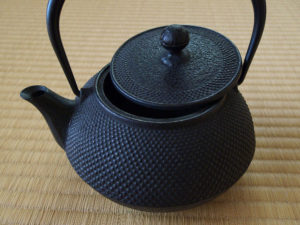
You’ve probably heard about the tetsubin (鉄瓶), which is the cast iron kettle.
In the West, it is common to use the same word when referring to Japanese cast iron teapots.
But in Japan, the correct name is tetsukyūsu (鉄急須), which means “iron teapot”.
Before we look at their differences, I want to tell you about the history of the tetsubin since it is much older.
History of the tetsubin
The tetsubin comes from the kama (釜), an ancient kettle that dates all the way back to the neolithic period in China.
In Japan, earthenware kama have been found from the Kofun period (300 to 538 AD).
Cast iron kama played an important role in the 15th century because of the Japanese tea ceremony.
These kettles are still used at tea ceremonies.
A type of kettle called tedorigama (手取り釜) seems to be the prototype of the tetsubin.
While there was a similar object used for medicinal purposes in 13th century Japan, the name tetsubin first appeared during the Edo period (1603 to 1867).
After loose leaf tea became more popular, it was common for Japanese households to have a kama in the kitchen, in case that a large amount of boiling water was needed.
The tetsubin was used to boil water for tea in the living room.
A famous type of tetsubin is the Nanbu tetsubin from Iwate prefecture.
However, the modern metallic kettle (the one with a traditional shape is called yakan in Japanese) and the electric kettle have mostly displaced the tetsubin.
What about the tetsukyūsu?
It is a more recent adaptation of the tetsubin, making it a teapot instead of a kettle.
Both look pretty much the same on the outside, although the teapot is usually smaller.
The tetsukyūsu has a filter, and unlike the tetsubin, it has an enamel coating inside.
This enamel protects the teapot so that it won’t rust easily. That means that you can leave tea inside for long periods of time without worries.
That’s one problem with the tetsubin, by the way. It requires more care than a modern kettle.
One shouldn’t boil water in the tetsukyūsu because the enamel coating will crack.
It’s for brewing tea only.
Since it is made of iron, one might think that it can withstand being placed on the stove. It’s a common mistake done by people who don’t know that it isn’t an iron kettle.
Should you own one these utensils?
In Japan, they are desired for aesthetic reasons, as they can be works of art.
The tetsubin also releases some iron into the water, which might be good for people with iron deficiency.
In the same manner, the taste of the resulting boiling water is different. Some say that it tastes “better”, which is highly subjective.
In my opinion, an electric tea kettle and a ceramic kyusu are superior.
The tetsukyūsu is quite heavy and might be difficult to wield when full.
It can easily scratch wood or other materials. And if you’re not careful, the lid could fall and it might cause considerable damage to your teaware, for example.
Because of the enamel, it won’t release iron into the tea.
So far, what I have experienced is that most Japanese tea enthusiasts prefer ceramic teapots instead of metallic ones.
Many Japanese books about tea won’t even mention the tetsukyūsu.
